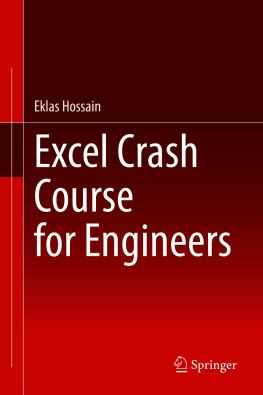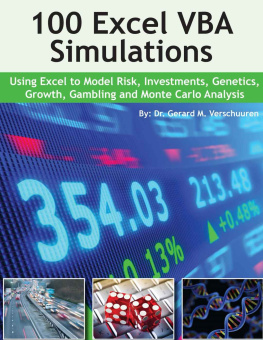INTRODUCTORY ECONOMETRICS
This highly accessible and innovative text and accompanying CD-ROM use Excel workbooks powered by Visual Basic macros to teach the core concepts of econometrics without advanced mathematics. These materials enable Monte Carlo simulations to be run by students with a click of a button. The fundamental teaching strategy is to use clear language and take advantage of recent developments in computer technology to create concrete, visual explanations of difficult, abstract ideas. Intelligent repetition of concrete examples effectively conveys the properties of the ordinary least squares (OLS) estimator and the nature of heteroskedasticity and autocorrelation. Coverage includes omitted variables, binary response models, basic time series methods, and an introduction to simultaneous equations. The authors teach students how to construct their own real-world data sets drawn from the Internet, which they can analyze with Excel or with other econometric software. The Excel add-ins included with this book allow students to draw histograms, find P-values of various test statistics (including DurbinWatson), obtain robust standard errors, and construct their own Monte Carlo and bootstrap simulations. For more, visit www.wabash.edu/econometrics.
Humberto Barreto is the DeVore Professor of Economics at Wabash College in Crawfordsville, Indiana. He received his Ph.D. from the University of North Carolina at Chapel Hill. Professor Barreto has lectured often on teaching economics with computer-based methods, including short courses with the National Science Foundations Chautauqua program. The author of The Entrepreneur in Microeconomic Theory, Professor Barreto has served as a Fulbright Scholar in the Dominican Republic and is the Manager of Electronic Information for the History of Economics Society.
Frank M. Howland is Associate Professor of Economics at Wabash College. He earned his Ph.D. in Economics from Stanford University. He was a visiting researcher at the Fundacin de Estudios de Economa Aplicada in Madrid, Spain. Howland has extensive experience designing spreadsheets and Visual Basic macros for intermediate microeconomics, statistics, and corporate finance courses. His academic research covers a variety of topics, including government crop support programs and the economics of higher education.
INTRODUCTORY ECONOMETRICS
Using Monte Carlo Simulation with Microsoft Excel
HUMBERTO BARRETO
Wabash College
FRANK M. HOWLAND
Wabash College

CAMBRIDGE UNIVERSITY PRESS
Cambridge, New York, Melbourne, Madrid, Cape Town, Singapore, So Paulo
Cambridge University Press
40 West 20th Street, New York, NY 10011-4211, USA
www.cambridge.org
Information on this title: www.cambridge.org/9780521843195
Humberto Barreto and Frank M. Howland 2006
This publication is in copyright. Subject to statutory exception and to the provisions of relevant collective licensing agreements, no reproduction of any part may take place without the written permission of Cambridge University Press.
First published 2006
Printed in the United States of America
A catalog record for this publication is available from the British Library.
Library of Congress Cataloging in Publication Data
Barreto, Humberto, 1960
Introductory econometrics : using Monte Carlo simulation with Microsoft Excel / Humberto Barreto, Frank M. Howland.
p. cm.
Includes bibliographical references and index.
ISBN-13: 978-0-521-84319-5 (hbk.)
ISBN-10: 0-521-84319-7 (hbk.)
1. Econometrics. 2. Monte Carlo method Data processing. 3. Microsoft Excel (Computer file)
I. Howland, Frank M., 1958 II. Title.
HB139.B376 2006
330.1518282 dc22 2005014585
ISBN-13 978-0-521-84319-5 hardback
ISBN-10 0-521-84319-7 hardback
Software on the CD-ROM accompanying this book is supplied as is and carries no warranty, express or implied, as to its fitness for a particular purpose. Cambridge University Press accepts no liability for loss or damage of any kind arising from use of this product.
Cambridge University Press has no responsibility for the persistence or accuracy of URLs for external or third-party Internet Web sites referred to in this publication and does not guarantee that any content on such Web sites is, or will remain, accurate or appropriate.
Humberto Barreto
Para mi familia, Tami, Tyler, Nicolas, y Jonah
Frank M. Howland
To my parents, Bette Howland and Howard Howland
Contents
IMRGDP.xls
Preface
I hear and I forget. I see and I remember. I do and I understand.
Confucius
The Purpose of This Book
We wrote this book to help you understand econometrics. This book is quite different from the textbooks you are used to. Our fundamental strategy is to use clear language and take advantage of recent developments in computers to create concrete, visual explanations of difficult, abstract ideas.
Instead of passively reading, you will be using the accompanying Microsoft Excel workbooks to create a variety of graphs and other output while you interact with this book. Active learning is, of course, the goal of the Excel files. You will work through a series of questions, discovering patterns in the data or illustrating a particular property. Often, we will ask you to create your own version of what is on the printed page. This is made easy by the many buttons and other enhancements we have incorporated in the Excel workbooks.
You may be worried that learning econometrics will be a long, hard journey through a series of boring and extremely puzzling mathematical formulas. We will not deny that acquiring econometrics skills and knowledge takes real effort you must carefully work through every Excel workbook and pay attention to detail but introductory econometrics has little to do with complicated mathematics, nor need it be boring. In fact, the core of econometrics relies on logic and common sense. The methods presented in this book can be used to help answer questions about the value of education, the presence of discrimination, the effects of speed limits, and much more.
Our Goals
This book embodies a new approach to teaching introductory econometrics. Our approach is dictated by our beliefs regarding the purposes of a first course in undergraduate econometrics and the most important concepts that belong in that course; our frustrations with the traditional equation-laden, proof-oriented presentation of econometrics; and our experience with computer simulation as a tool that can overcome many of the limitations of traditional textbooks.
In terms of a students educational development, there are short- and long-term reasons for including an introductory econometrics course in the undergraduate economics curriculum. Three major short-term goals for such a course stand out. A fundamental purpose of a first course in econometrics is to enable students to become intelligent readers of others econometric analyses. To do so, they need to be able to interpret coefficient estimates and functional forms; understand simple inferential statistics, including the sampling distribution; and go beyond accepting all results at face value. A more ambitious introductory course should teach students to conduct creditable elementary econometric research. Students should be able to gather and document data, choose appropriate functional forms, run and interpret multiple regressions, conduct hypothesis tests and construct confidence intervals, and describe the major limitations of their analyses. Finally, an introductory course should prepare some students to take a second course in econometrics. Students who will take a second course ought to come to appreciate the method of least squares, the logic of the GaussMarkov theorem, and the distinction between finite sample and asymptotic results.
Next page








